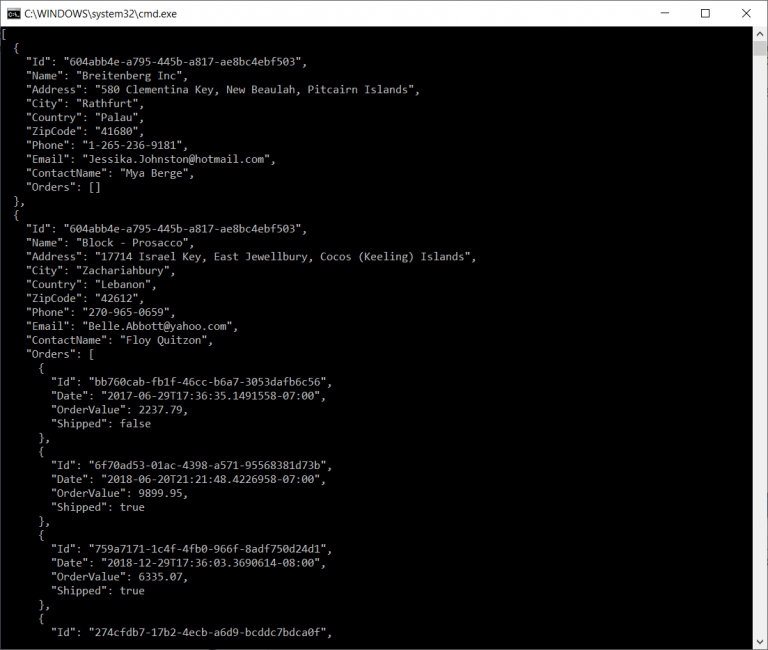原文:CREATING SAMPLE DATA FOR C#
作者:Bruno Sonnino
译文:C#中使用Bogus创建模拟数据
译者: Lamond Lu
背景
在我每次写技术类博文的时候,经常做的一件事就是创建模拟数据。在每篇博文中,为了解释某些概念,我需要创建许多模拟数据。这是一个我在实际中遇到的问题,因为我需要为我的程序找到一些合适的数据。有些时候,我会从数据库中找一些数据(Northwind和AdventureWorks都是我的好朋友.), 有些时候,我会使用一些现成的Json或者Xml数据,当然有时候我只能自己手动创建一些数据。
当然以上方案都不完美,也都不稳定,所以每次我都需要探索一些新方式来获取数据(对于学习来说这很好,但是维护起来确是一种灾难)。
最后我找到了Bogus, 一个基于C#的简单数据生成器。

使用Bogus生成模拟数据, 你只需要定义规则并生成数据即可,就是这么简单。而且Bogus可以生成固定数据或者变化数据。这样一旦你拿到了这些数据,你就可以把它们序列化成你想要的格式: json, xml,数据库或者文本文件。
生成模拟数据
为了生成模拟数据,我们首先需要针对模拟数据创建对应的实体类。这里我们可以创建一个命令行程序,并添加一下两个类。
public class Customer
{
public Guid Id { get; set; }
public string Name { get; set; }
public string Address { get; set; }
public string City { get; set; }
public string Country { get; set; }
public string ZipCode { get; set; }
public string Phone { get; set; }
public string Email { get; set; }
public string ContactName { get; set; }
public IEnumerable<Order> Orders { get; set; }
}
public class Order
{
public Guid Id { get; set; }
public DateTime Date { get; set; }
public Decimal OrderValue { get; set; }
public bool Shipped { get; set; }
}
在你创建好以上两个实体类之后,你就可以来添加仓储来获取模拟数据了。为了使用Bogus, 你可以使用Nuget将Bogus库添加到你的项目中。
Install-Package Bogus
下面我们就可以来添加一个仓储类来获取模拟数据了。这里我们添加一个SampleCustomerRepository类,并加入以下方法。
public IEnumerable<Customer> GetCustomers()
{
Randomizer.Seed = new Random(123456);
var ordergenerator = new Faker<Order>()
.RuleFor(o => o.Id, Guid.NewGuid)
.RuleFor(o => o.Date, f => f.Date.Past(3))
.RuleFor(o => o.OrderValue, f => f.Finance.Amount(0, 10000))
.RuleFor(o => o.Shipped, f => f.Random.Bool(0.9f));
var customerGenerator = new Faker<Customer>()
.RuleFor(c => c.Id, Guid.NewGuid())
.RuleFor(c => c.Name, f => f.Company.CompanyName())
.RuleFor(c => c.Address, f => f.Address.FullAddress())
.RuleFor(c => c.City, f => f.Address.City())
.RuleFor(c => c.Country, f => f.Address.Country())
.RuleFor(c => c.ZipCode, f => f.Address.ZipCode())
.RuleFor(c => c.Phone, f => f.Phone.PhoneNumber())
.RuleFor(c => c.Email, f => f.Internet.Email())
.RuleFor(c => c.ContactName, (f, c) => f.Name.FullName())
.RuleFor(c => c.Orders, f => ordergenerator.Generate(f.Random.Number(10)).ToList());
return customerGenerator.Generate(100);
}
这里的第三行代码,我们为
Randomizer.Seed属性指定一个固定的随机种子,因此每次生成的数据都是一样的。如果你不希望每次都生成固定的数据,你可以去掉这行代码。
这里我们为订单和客户数据的生成定义了规则,然后我们调用了Generate方法来生成模拟数据。就是这么简单。
如上所见,Bogus提供了许多类来生成数据。例如Company类可以用来生成公司模拟数据,例如公司名称。你可以使用这些生成的数据作为你程序的模拟数据,这些数据有3种使用场景
- 单元测试的模拟测试数据
- 设计阶段的模拟数据
- 原型的模拟数据
但是我确信,你能发现更多的使用场景。
这里为了使用这些数据,你可以在Main方法中加入以下代码
static void Main(string[] args)
{
var repository = new SampleCustomerRepository();
var customers = repository.GetCustomers();
Console.WriteLine(JsonConvert.SerializeObject(customers,
Formatting.Indented));
}
这里我们将模拟数据转换成了Json字符串,所以这里你需要添加对Newtonsoft.Json库的引用。当你运行程序之后,你会得要以下结果。

如上所见,程序生成了一个顾客的数据集,并附带了每个顾客的所有订单信息。